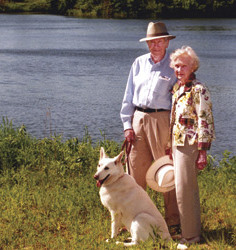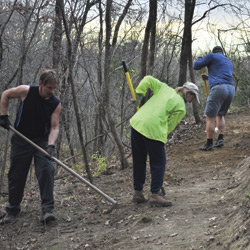Ask anyone who grew up in central Illinois over the last 30 years about Wildlife Prairie State Park, and they’re likely to express warm feelings about this “crown jewel of the Midwest.” I’m certainly no exception. Whether at church gatherings, school field trips or family mini-vacations, the 2,000-acre zoological park west of Peoria looms large as a setting for some of my earliest memories.
Over the years, the park has grown to become indispensable to central Illinois. It’s difficult to imagine the region without it, but it’s all too easy to take for granted. With state funds having dried up, a new community group has stepped up to the plate to take charge of the park and ensure that it is around for generations to come.
An Intricate Patchwork
On the surface, the park is a place to enjoy the simple things in life—the great outdoors, and the marvelous animal and plant life native to the Midwestern prairie—but in terms of the property and its operations, it’s a rather complex web of relationships.
The park was famously established by local philanthropist and businessman Bill Rutherford Sr. and his wife, Hazel, whose Forest Park Foundation has been instrumental in establishing so many of the region’s greatest assets, from Forest Park Nature Center to the Rock Island Trail to the Peoria Heights Observation Tower.
In the late 1960s, the foundation began working with the Chicago Zoological Society, intending to use the land as a breeding farm for endangered species at the Brookfield Zoo. But when the zoo underwent a major renovation and change in management, those plans fell through, and a new idea emerged. With the mission of preserving and displaying the native plants and animals of Illinois, Wildlife Prairie Park opened its doors to the public in the fall of 1978, and in the three decades since, the Forest Park Foundation has operated the facility.
On September 5, 2000, after years of negotiations, Bill Rutherford Sr. presented the deed to the park to then-Governor George Ryan, and Wildlife Prairie Park became the Hazel & Bill Rutherford Wildlife Prairie State Park. Although it was now owned and supported by the state, the Forest Park Foundation continued to manage its operations under a contract with the Illinois Department of Natural Resources.
 A Deadbeat State
A Deadbeat State
With a $13 billion budget deficit, “Illinois will be confronting the most dangerous fiscal conditions in modern history,” warned Comptroller Dan Hynes in his most recent assessment of the state’s finances. Sadly, this is news to no one. Record payment delays are impacting school districts, social services and other state programs across the board, and neither the governor nor the state legislature has taken the steps necessary to address the issue.
Wildlife Prairie State Park is just one of many entities whose funding has been affected. It received no funding in the 2009 fiscal year. The $640,000 that was promised for 2010 was only recently received—several months late, of course. And there is not a dime for the park in the 2011 budget.
“The state’s lack of payment has had a huge impact on the park,” said Dr. John Erwin, president of Illinois Central College, who is actively helping to guide the park to a firm footing. “Certainly, the impetus right now for changing the governance and looking at a different funding model is a direct result of the State of Illinois not living up to its promises.”
Before he passed away in 2006, Bill Rutherford Sr. had anticipated this possibility. “When he was still living, he came to [then-] Congressman Ray LaHood’s office and asked that a community group be formed to help raise support for the park’s long-term future,” recalled Brad McMillan, who has also been deeply involved in efforts to sustain the park. “He knew that community support was critical to keeping this jewel of an asset in good shape for future generations to enjoy. As district chief of staff to Congressman LaHood and an enthusiast for the park, I asked a talented group of community leaders to form the original Friends of Wildlife Prairie State Park.”
Over the last several years, scores of people have been involved in considering alternative funding and operational options for the park, from Bill Rutherford Jr., who now presides over the Forest Park Foundation, to State Rep. David Leitch, who has worked tirelessly to bring a variety of voices to the table. McMillan served as president of the Friends of Wildlife Prairie State Park board, and for several years, has led the annual banquet and other fundraising activities to supplement its revenue.
 Meet the New Friends
Meet the New Friends
Since the founding of the original Friends board, the state’s finances have only deteriorated further—a fact unlikely to change anytime in the near future. The Forest Park Foundation, which has so often bridged the funding gap, is tapped out, and would like to focus its resources on other endeavors. And so, in order to ensure its perpetual operations, an agreement was finalized in October that turned over operational responsibility of the park to a new board—the culmination of several years of collaborative efforts from a wide range of area leaders, and a testament to how beloved the park is locally.
The mission of the new Friends of Wildlife Prairie State Park, restructured as a 501(c)(3) charitable organization and now chaired by Caterpillar CEO Doug Oberhelman, goes far beyond the fundraising role of its predecessor. “The new governing board will oversee all operations of the park, establish a balanced budget and a strategic plan, and start to build an endowment for the park’s long-term sustainability,” explained McMillan.
The development of a capital campaign is one of the board’s key charges. “Heretofore, there has not been a capital campaign—a way to create an enduring endowment that will be there for the park into the future,” said Dr. Erwin, president of the new Friends board.
In addition, the board will put together a strategic business plan for the park—with measurable milestones to mark progress toward its goals.
Some of these milestones include:
- An increase in memberships by a certain percentage annually
- An increase in annual visitors to the park
- A balanced budget between revenues and expenditures
- Improved processes across the park, from maintenance to special events.
“I think those are four very clear and important ways that the park gets on the right path,” noted Erwin. The Forest Park Foundation has agreed to invest several million dollars into the park over the next four years, but in order to receive the continued investment, the board must meet certain expectations. It will put together a report each year in June detailing its progress.
Leading Change
And so, change is afoot at the park. With a balanced budget as the top priority, all staff were offered voluntary separation packages this summer; about half accepted. Jeff Rosecrans was retained by the Friends board to manage the day-to-day operations of the facility, and retired Dunlap School District Superintendent Jeanne Williamson was named general manager.
“I will be interfacing directly with the governing board,” noted Williamson of her new role. Her administrative and managerial experience will be critical in implementing the park’s strategic plan and capital campaign, and her educational background will be significant as the park looks to enhance its programs and build community partnerships.
“We will be developing some new and exciting programs in our education department,” said Williamson. “We’re going to form an education advisory board consisting of many of the principals and superintendents in central Illinois. We already do some wonderful things, but I hope that with my background, we can enhance and develop using the park as an educational setting. That’s really a passion of mine.”
Outside of the educational arena, the park is looking at a host of operational changes, as well as new partnerships and programs to drive more people to the facility. This winter, for example, the park will stay open on weekends for the first time, and a host of other ideas are being considered. “We hope that in the near future, possibly in the spring of 2011, there will be some different exhibits and events that would capture this interest,” added Erwin.
“Ultimately, our goal is to provide a better level of service,” explained Rosecrans. “This year, we really put a new face to Wildlife Scary Park…it’s a much better event than what it historically has been. And we’ve developed some new partnerships, such as with the Peoria Area Mountain Bike Association, which has developed about seven miles of mountain biking trails on our site.
“We’re looking at having our first mountain bike races in March,” he continued. “We’ve held two triathlons here at this point, and we’re looking at a partnership with Rocking C Stables to bring a horse riding day camp here.” A disc golf course is being developed at the park. The Olde English Faire, which was held at the park for the first time last year, will return in 2011. Other ideas being considered include fishing and cross-country tournaments, guided horse trail rides and new options for camping.
“We’re also looking at the animal life,” said Erwin. “Is there a way for us to enhance the size of the bison herd, for example? Can we add any additional animals that were indigenous to the prairie that would be attractive to visitors?
“It really lends itself to creativity and innovation, and there’s almost no end to the possibilities,” he added. “The key is that the governing board will make sure that the revenue to the expenditure of any event or enhancement is matched so that we’re not venturing forth with a huge financial risk.”
 Look to the Future
Look to the Future
In the end, this financial crisis—and the difficulties of transitioning to a new operating model—while painful in the short run, may stand to be of great benefit in the long run. Not only will the park’s long-term sustainability be secured, but many of the new collaborative possibilities hinted at would probably not have been examined under normal circumstances. With hindsight, the crisis may end up being quite an opportunity.
“I think this is going to change the face of the park,” said Williamson. “The financial crisis we’re in will allow us to foster a lot of growth and development in some very different areas, while still maintaining the focus of conservation and education. We’re going to try to take that piece of it —that has been here and has existed under the Rutherford family—and build on that.”
The first step is to bring financial stability to the park, and the capital campaign will be key to that effort. It will launch this spring at the Hotel Père Marquette’s annual fundraising gala, which raises money for a different not-for-profit organization each year and has designated the park as its 2011 beneficiary. “We’re very fortunate to be the charity of choice for the gala event,” said Rosecrans. “That will be a very nice kickoff to the capital campaign. We’ve been given the charge to raise half a million dollars by the end of June, and that’s our challenge.”
“We can have all these ideas to enhance the park,” added Williamson, “but if we don’t establish financial controls that will bring in profits, we won’t see development. So the finances are the No. 1 priority.”
“The community really embracing the park is a key point,” added Erwin. “It’s clear that we’ve set a course that weans the park from the Forest Park Foundation. Can it really survive on its own? That’s the biggest question. The answer will come in how well the community responds.” iBi


